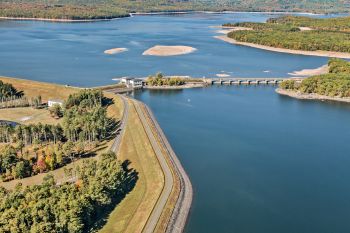Embankment Dams: Difference between revisions
Rmanwaring (talk | contribs) (Created page with "__NOTOC__ Earthen/Rockfill Dams, also referred to as Embankment Dams, are constructed using layers of compacted soil. These types of dams are often constructed using layers of soil with varying levels of hydraulic conductivities in order to prevent excessive seepage through the embankment. These types of dams are subject to cracking from seismic or consolidation and subsequent internal erosion due to seepage, which is prevented by using engineered filters and monitored...") |
Rmanwaring (talk | contribs) |
||
| Line 7: | Line 7: | ||
[[File:2014_NY-AshokanDam.jpg | right | border | 350px | link= | Ashokan Dam]] | [[File:2014_NY-AshokanDam.jpg | right | border | 350px | link= | Ashokan Dam]] | ||
==='''Components of Earthen/Rockfill Dams'''=== | ==='''[[Components of Earthen/Rockfill Dams]]'''=== | ||
*[[Embankment]] | *[[Embankment]] | ||
**[[Zoning]] | **[[Zoning]] | ||
Revision as of 20:21, 6 June 2022
Earthen/Rockfill Dams, also referred to as Embankment Dams, are constructed using layers of compacted soil. These types of dams are often constructed using layers of soil with varying levels of hydraulic conductivities in order to prevent excessive seepage through the embankment. These types of dams are subject to cracking from seismic or consolidation and subsequent internal erosion due to seepage, which is prevented by using engineered filters and monitored through the use of piezometers. The following list contains links to pages containing additional information regarding the major components of an Earthen/Rockfill Dam and how they are monitored in the field. Click to learn more.

Components of Earthen/Rockfill Dams
Life Cycle of Earthen/Rockfill Dams
Last revised by: Rmanwaring
Revision ID: 849
Revision Date: 06/06/2022
